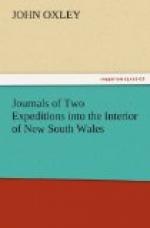of being able to effect a passage. As we had
always experienced the difficulty, not to say impracticability
of attempting to go round such inlets as these. we
stopped about half a mile inside the entrance, on
a spot affording good grass and water for the horses,
the greater part of which were entirely knocked up;
insomuch that I began to fear we would take very few
of them to Newcastle. It being early in the day,
a party proceeded to explore the shores of the inlet,
to ascertain if it was possible for us to proceed
round it. After several hours’ examination,
and walking from six to eight miles, we were obliged
to give up all intention of proceeding circuitously;
and found that our efforts must be directed to effect
a passage near the entrance, since numerous fresh water
runs having their source in deep and impassable swamps
or lagoons, presented an insurmountable barrier to
the horses. The main inlet extended in two wide
and extensive branches to the south-west and west,
the termination of which could not be seen, the water
being apparently deep; and the country to the westward
rising into forest hills. In this perplexing
situation, with no other prospect before us but that
of effecting our own passage in a bark canoe, and
being obliged to leave the horses behind us; since
the width of the channel (which at low water we had
the satisfaction to perceive did not exceed a quarter
of a mile) and the extreme rapidity of the tide, which
ran at the rate of at least three miles per hour,
precluded all reasonable hope that, in their present
weak state, they would have strength to swim over.
In this state, the boat which had been washed on the
beach suddenly occurred to us. It was true that
we were twelve or fourteen miles distant from it,
and that we should have to carry her that distance
on men’s shoulders, but to persons in our situation
such difficulties were as nothing. It was therefore
determined that twelve men should depart before day,
and use their efforts to bring her to the tent, whilst
those that remained to take care of the horses and
baggage should be preparing materials to give her
such repair as must necessarily be required.
We had now fully experienced how little dependance
can be placed on the best marine charts, to show all
the inlets and openings upon an extensive line of
coast. Perhaps no charts can be more accurate
than those published by Captain Flinders, the situation
of the principal headlands and capes, with the direction
of the coast, being laid down with the most minute
attention to truth; but the distance at which he was
obliged to keep, although it did not prevent him from
laying the coast line down with an accuracy of outline
sufficient for all nautical purposes, did not allow
him to perceive openings which, though doubtless of
little consequence to shipping, yet present the most
serious obstacles to travellers by land; and of which,
if they had been laid down in the chart, I should
have hesitated to have attempted the passage without




